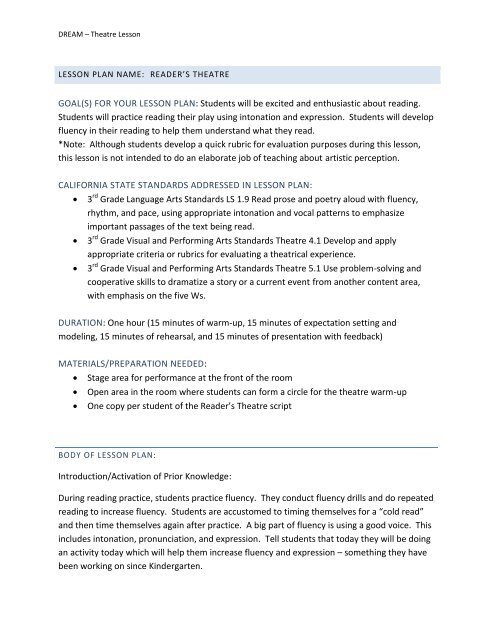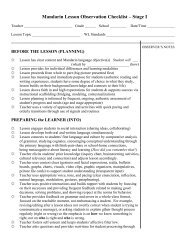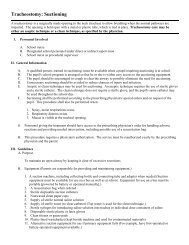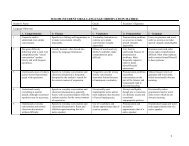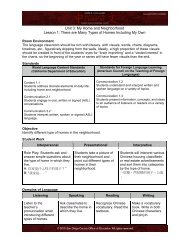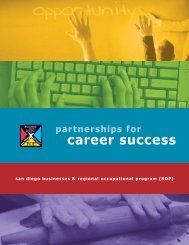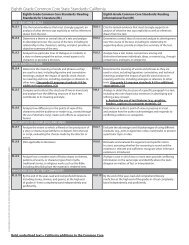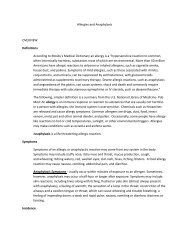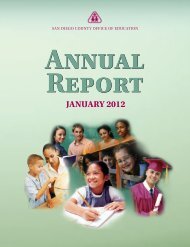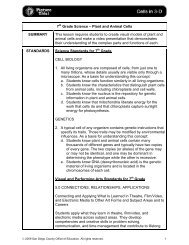LESSON PLAN FORMAT - dream
LESSON PLAN FORMAT - dream
LESSON PLAN FORMAT - dream
You also want an ePaper? Increase the reach of your titles
YUMPU automatically turns print PDFs into web optimized ePapers that Google loves.
DREAM – Theatre Lesson<strong>LESSON</strong> <strong>PLAN</strong> NAME: READER’S THEATREGOAL(S) FOR YOUR <strong>LESSON</strong> <strong>PLAN</strong>: Students will be excited and enthusiastic about reading.Students will practice reading their play using intonation and expression. Students will developfluency in their reading to help them understand what they read.*Note: Although students develop a quick rubric for evaluation purposes during this lesson,this lesson is not intended to do an elaborate job of teaching about artistic perception.CALIFORNIA STATE STANDARDS ADDRESSED IN <strong>LESSON</strong> <strong>PLAN</strong>:3 rd Grade Language Arts Standards LS 1.9 Read prose and poetry aloud with fluency,rhythm, and pace, using appropriate intonation and vocal patterns to emphasizeimportant passages of the text being read.3 rd Grade Visual and Performing Arts Standards Theatre 4.1 Develop and applyappropriate criteria or rubrics for evaluating a theatrical experience.3 rd Grade Visual and Performing Arts Standards Theatre 5.1 Use problem-solving andcooperative skills to dramatize a story or a current event from another content area,with emphasis on the five Ws.DURATION: One hour (15 minutes of warm-up, 15 minutes of expectation setting andmodeling, 15 minutes of rehearsal, and 15 minutes of presentation with feedback)MATERIALS/PREPARATION NEEDED: Stage area for performance at the front of the room Open area in the room where students can form a circle for the theatre warm-up One copy per student of the Reader’s Theatre scriptBODY OF <strong>LESSON</strong> <strong>PLAN</strong>:Introduction/Activation of Prior Knowledge:During reading practice, students practice fluency. They conduct fluency drills and do repeatedreading to increase fluency. Students are accustomed to timing themselves for a “cold read”and then time themselves again after practice. A big part of fluency is using a good voice. Thisincludes intonation, pronunciation, and expression. Tell students that today they will be doingan activity today which will help them increase fluency and expression – something they havebeen working on since Kindergarten.
DREAM – Theatre LessonTeaching the Lesson:1. Clear the desks to the outside edges of the room so there is an open stage area in themiddle of the room.2. Have students form a circle and play the game “Zip”. The purpose of this game is toloosen the students up, especially those who are shy and uncomfortable participating invocal activities. It is great for second language learners and helps them speak up in anon-threatening environment.“Zip” 15 minutes: This is a focusing and team-building activity. Organize the group intoa circle. If the group is unfamiliar with each other, go around once and have each personsay his or her name. Establish a beat by slapping one hand against your thigh. Have thegroup join in the rhythm. Group members place their other free hand up by theirshoulders, with the index finger and thumb extended as if it were a gun. One personstarts zip by pointing to an individual across the circle and saying his or her own name.Without missing a beat, the person who is pointed to points to another person and sayshis or her own name. Gradually pick up the pace of the rhythm. A person is out if he orshe falters on a beat, or neglects to say his or her own name properly. The group'sinstinct will be to say the name of the person pointed to, but the point is to maintainfocus enough to escape that mechanized response and say one's own name withoutmissing a beat. SOURCE: http://members.tripod.com/~yep_team/warmup.html)3. Distribute scripts to students. Break them up into small groups so that the number ofstudents matches the number of parts in the Reader’s Theatre script. Introduce theelements of the play: title, author, setting, and characters. Provide students withbackground information so they can use this information to develop their characters.4. Display script on the overhead or elmo. Read through it together, discussing anyunfamiliar words. Define vocabulary as needed. Have students relate this play to anyprior experiences. For example, if the play is about the Mayflower Journey, studentsmay have read about this topic during Social Studies time.5. Read through the entire play using a strategy such as echo reading or choral reading sostudent become familiar with the text.6. Discuss the expectations for rehearsal and presentation. Together, brainstorm a rubricby which the students will be assessed with regard to their group performance. Startwith the top grade (it can be a 4-3-2-1 scale). Have student list what they would expect
DREAM – Theatre Lessonto see the group do from beginning (rehearsal) to end (performance). List these criteriaon the board.7. Assign parts, model expectations for group work and remind students to work onstaging for the final performance. Provide time for rehearsal within the group.Guided Practice:1. Students will work in their groups and read through the play together.2. Students will assist other students with unfamiliar words.3. Students will rehearse the play several times together. They will focus on readingfluently and with appropriate expression. They will design appropriate stagingmovements together as a group.4. Teacher circulates to give feedback to the character, not the student 5. Parent helpers are advised to work with individual groups.Conclusion:1. Students will perform for the class.2. Students will “grade” their peers based on the rubric they designed.3. Students will practice giving positive feedback.Extension Activities:1. Challenge groups can write, rehearse, and present their own “Reader’s Theatre” plays.They can use the Reader’s Theatre Web Quest:http://www.swsd.k12.pa.us/~barb_schumacher/Webquests/ReadersTheaterWebQuest.htm2. Students can reflect in a writing journal to write about their experiences as an actorand/or director.3. Students can write a new ending for the play.4. Students can perform for larger audiences: parents, administration or the community.
DREAM – Theatre LessonAssessment:1. Informal teacher assessment done during rehearsals2. Rubric assessment by teacher and/or peer3. Journal reflection as assessmentResearch Reference: SOURCE: http://www.forpd.ucf.edu/strategies/stratReadersTheater.html“Oral reading fluency is one of the five major components of a research-based reading program (National ReadingPanel, 2000). Reading fluently refers to the ability to read text with automaticity, accurately, and with goodprosody. When students read fluently they are able to spend less energy on decoding and pronunciationstrategies and focus more on the overall goal of reading: constructing meaning from text. It has often been foundthat students, who struggle with comprehension, also struggle with fluency (Rasinski, 2003).Rasinski offers four ways to build reading fluency including modeling good oral reading, providing oral support forreaders such as with choral reading or paired reading, offering plenty of practice opportunities as with repeatedreadings, and encouraging fluency through phrasing (Rasinski, 2003). Use of these instructional suggestions, alongwith discussion on the importance of fluency, can help students who believe that a “good reader” never makesmistakes understand that accuracy without expression or comprehension is not true reading. When consideringfluency instruction there are many strategies and techniques to consider to best support your learners.Reader's Theater, a "highly successful classroom instructional model for fluency based on sound theory andresearch" (Scraper, 2006, p. 2), provides students with modeling, practice, support, and a focus on expression andphrasing. Reader's Theater is an oral and sometimes, visual activity in which students read scripts or stories, eachtaking the part of one of the characters or narrator, to bring the text to life (Martinez, Roser & Strecker, 1999;Prescott-Griffin & Witherell, 2004). There is no need for an actual production of a play or theatrical event althoughprops may be used. The goal of this strategy is to help students with their fluency and comprehension by allowingthem rehearsal time to practice reading with expression and prosody, the opportunity to read and reread formeaning, and the ability to focus on word meanings.”


